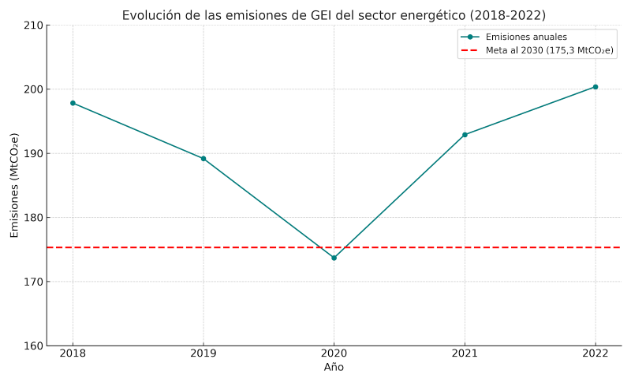11.1
Published onNet emissions from the energy sector reached 200.37 MtCO₂e in 2022, according to the National Greenhouse Gas Inventory (INGEI 2024) and the First Biennial Transparency Report (BTR1, 2024). This value exceeds the sectoral objective of 175.3 MtCO₂e for 2030 by 25.07 MtCO₂e (14.3%). To meet that objective, the sector would need to reduce at least 3.13 MtCO₂e per year between 2023 and 2030. However, there is no evidence of a sustained downward trajectory or of implemented policies with proven capacity to maintain such a pace of reductions.
The historical series (see Figure 1) shows a fluctuating trend, with a minimum in 2020 (173.7 MtCO₂e) associated with the drop in activity during the pandemic, followed by a sustained increase: in just two years emissions grew by 26.7 MtCO₂e, reaching a recent peak in 2022. There are currently no official data beyond 2022 nor updated public projections that would allow assessment of a possible trend change. Both the National Energy Transition Plan to 2030 and the First Progress Report of the Second National Plan for Adaptation and Mitigation to Climate Change (2024) lack recent quantitative information and do not present an explicit link between proposed policies and expected outcomes in emissions reductions.
At a structural level, complementary indicators confirm this lack of progress. In 2022, the share of renewable sources in primary and final energy supply was 12%, well below the interim target of 25% for 2025 and the final target of 29% by 2030. Meanwhile, natural gas maintains a dominant 54% share in the energy mix (BTR1, 2024, p. 90). Although this fuel is less emissions-intensive than coal or oil, its massive use without an active transition strategy can limit structural emissions reductions.
At the macroeconomic level, the carbon intensity of GDP also does not show sustained improvement. Between 2018 and 2019, the indicator fell from 546.06 to 500.56 MtCO₂e per million pesos of 2004 (BTR1, 2024), indicating improved climate efficiency. However, in 2020 it spiked to 629.15 due to the sharp contraction of GDP during the pandemic. In subsequent years the intensity fell again, but in 2022 (552.38) it was still above the 2019 level. This suggests that, despite some partial recovery of activity between 2020 and 2022, a decoupling between economic growth and emissions has not been consolidated. Although this indicator is not specific to the energy sector, its evolution reflects the persistence of a carbon-intensive economic structure (see Table 2).
No updated data have been published on the energy intensity of GDP or on the rate of clean-technology adoption in generation, transport, or consumption. Likewise, no monitoring mechanisms or public reports have been identified that would allow precise assessment of progress in the sector’s decarbonization.
Consequently, the available evidence shows that the energy sector does not exhibit clear signs of a transformation consistent with the established climate objectives. Emissions remain at high levels and verifiable results are not being reported. Therefore, it is appropriate to rate the sectoral commitment as no progress.
Figure 1. Evolution of GHG emissions from Argentina’s energy sector (2018–2022)

Source: Sol Lofeudo (2025), based on data obtained from the interactive platform of the National Greenhouse Gas Inventory and Mitigation Measures Monitoring (INGEI, 2024). Work prepared for Latam Lab (2025).
Table 1. Historical series of net GHG emissions from the energy sector in Argentina (2018–2022)
Source: Sol Lofeudo (2025), based on data obtained from the interactive platform of the National Greenhouse Gas Inventory and Mitigation Measures Monitoring (INGEI, 2024). Work prepared for Latam Lab (2025).
Table 2. Historical series of net GHG emissions, economic value, and GDP carbon intensity in Argentina (2018–2022)
Source: Database of the interactive platform of the National Greenhouse Gas Inventory and Mitigation Measures Monitoring (INGEI, 2024).
References
-
Ministry of Environment and Sustainable Development. (2022). Long-Term Strategy for Low-Emission, Climate-Resilient Development to 2050. Government of the Argentine Republic.
-
Secretariat of Energy. (2023). National Energy Transition Plan to 2030. Ministry of Economy, Government of the Argentine Republic. (IF-2023-70145558-APN-SSPE#MEC).
-
Secretariat of Energy. (2022). Resolution No. 438/2022. Official Gazette of the Argentine Republic. https://www.argentina.gob.ar/normativa/nacional/resoluci%C3%B3n-438-2022-366630/texto
-
Undersecretariat for Environment. (2024). National Greenhouse Gas Inventory: First Biennial Transparency Report. Argentina 2024 (ISBN 978-631-00-6500-7). Secretariat for Environment, Tourism and Sports, Office of the Deputy Chief of Staff for the Interior.
-
Undersecretariat for Environment. (2024). First Progress Report: Implementation of the Second National Plan for Adaptation and Mitigation to Climate Change. Ministry of Environment and Sustainable Development, Government of the Argentine Republic.
-
Undersecretariat for Environment. (2024). National GHG Inventory – Interactive results platform. Ministry of Environment and Sustainable Development. https://inventariogei.ambiente.gob.ar/resultados

